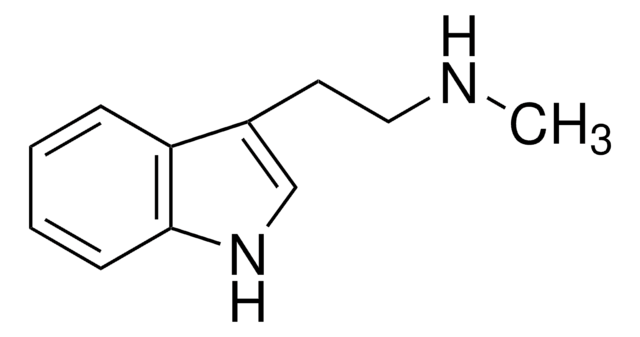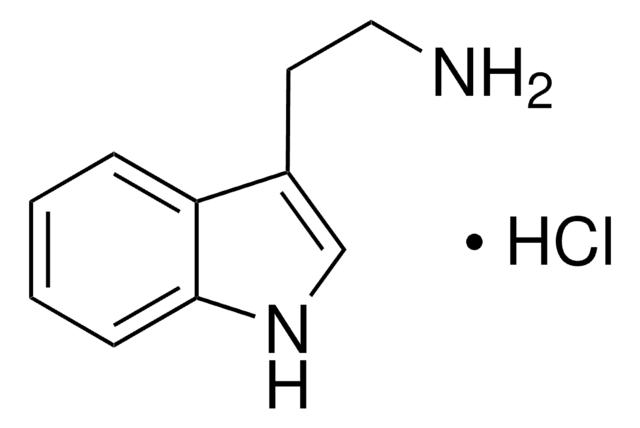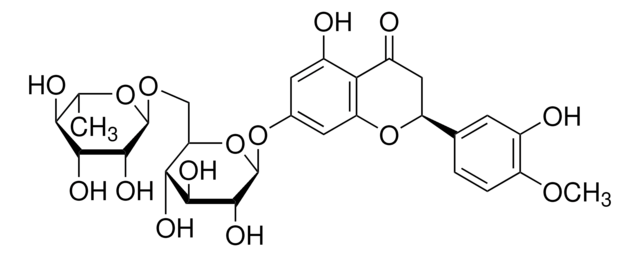すべての画像(1)
About This Item
実験式(ヒル表記法):
C12H16N2
CAS番号:
分子量:
188.27
MDL番号:
UNSPSCコード:
12352116
PubChem Substance ID:
NACRES:
NA.77
おすすめの製品
品質水準
アッセイ
≥97% (HPLC)
フォーム
powder
薬剤管理
USDEA Schedule I; regulated under CDSA - not available from Sigma-Aldrich Canada; psicótropo (Spain); Decreto Lei 15/93: Tabela IIA (Portugal)
色
white to beige
溶解性
DMSO: 15 mg/mL, clear
保管温度
−20°C
SMILES記法
CN(C)CCC1=CNC2=C1C=CC=C2
InChI
1S/C12H16N2/c1-14(2)8-7-10-9-13-12-6-4-3-5-11(10)12/h3-6,9,13H,7-8H2,1-2H3
InChI Key
DMULVCHRPCFFGV-UHFFFAOYSA-N
類似した製品をお探しですか? 訪問 製品比較ガイド
生物化学的/生理学的作用
N,N-Dimethyltryptamine (DMT) functions as a hallucinogen. Experimental studies states that DMT is an endogenous sigma-1 receptor agonist. DMT interacts with sigma-1 receptors and blocks voltage-gated sodium ion (Na+) channels in both native cardiac myocytes and heterologous cells that contain sigma-1 receptors.
N,N-Dimethyltryptamine (DMT) is a hallucinogen now known to be an endogenous sigma-1 receptor agonist. In keeping with the known sigma-1 receptor modulation of voltage gated Na+ channels, DMT was found to reversibly inhibit Na currents by 62% in vitro. N,N-Dimethyltryptamine also induced hypermotility in WT mice (but not in sigma-1 KO mice), all evidence of its sigma-1 agonist activity.
N,N-Dimethyltryptamine is an endogenous sigma-1 receptor agonist; hallucinogen.
特徴および利点
This compound is a featured product for Neuroscience research. Click here to discover more featured Neuroscience products. Learn more about bioactive small molecules for other areas of research at sigma.com/discover-bsm.
その他情報
Product contains 1.2% wt. EtOH (by NMR and EA).
シグナルワード
Warning
危険有害性情報
危険有害性の分類
STOT SE 3
ターゲットの組織
Central nervous system
保管分類コード
11 - Combustible Solids
WGK
WGK 3
引火点(°F)
Not applicable
引火点(℃)
Not applicable
適用法令
試験研究用途を考慮した関連法令を主に挙げております。化学物質以外については、一部の情報のみ提供しています。 製品を安全かつ合法的に使用することは、使用者の義務です。最新情報により修正される場合があります。WEBの反映には時間を要することがあるため、適宜SDSをご参照ください。
Jan Code
SML0791-VAR:
SML0791-25MG:
SML0791-5MG:
SML0791-SMPL:
SML0791-BULK:
SML0791-IP:
最新バージョンのいずれかを選択してください:
Arturo A Vitale et al.
Journal of nuclear medicine : official publication, Society of Nuclear Medicine, 52(6), 970-977 (2011-05-31)
N,N-dimethyltryptamine (DMT), a strong psychodysleptic drug, has been found in higher plants, shamanic hallucinogenic beverages, and the urine of schizophrenic patients. The aim of this work was to gain better knowledge on the relationship between this drug and hallucinogenic processes
Tsung-Ping Su et al.
Science signaling, 2(61), pe12-pe12 (2009-03-13)
N,N-dimethyltryptamine (DMT) is a hallucinogen found endogenously in human brain that is commonly recognized to target the 5-hydroxytryptamine 2A receptor or the trace amine-associated receptor to exert its psychedelic effect. DMT has been recently shown to bind sigma-1 receptors, which
Ethan H McIlhenny et al.
Biomedical chromatography : BMC, 25(9), 970-984 (2010-11-09)
Ayahuasca, also known as caapi or yage among various South American groups, holds a highly esteemed and millennia-old position in these cultures' medical and religious pharmacopeia. There is now an increasing interest in the potential for modern medical applications of
The Hallucinogen N,N-Dimethyltryptamine (DMT) Is an Endogenous Sigma-1 Receptor Regulator.
Dominique F, et al.
Science, 323(5916), 934-937 (2009)
Paulo Cesar Ribeiro Barbosa et al.
Drug testing and analysis, 4(7-8), 601-609 (2012-07-05)
Ayahuasca is a psychedelic brew originally used for magico-religious purposes by Amerindian populations of the western Amazon Basin. Throughout the last four decades, the use of ayahuasca spread towards major cities in all regions of Brazil and abroad. This trend
ライフサイエンス、有機合成、材料科学、クロマトグラフィー、分析など、あらゆる分野の研究に経験のあるメンバーがおります。.
製品に関するお問い合わせはこちら(テクニカルサービス)









